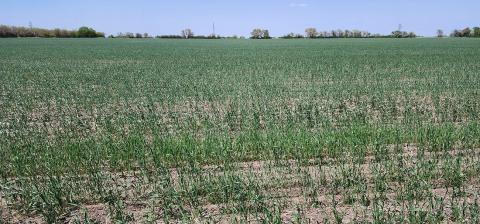After-harvest Wheat Disease Management Strategies for Reducing Losses in 2024
July 13, 2023
Strategies that can be used between now and planting winter wheat this fall to minimize losses due to diseases during next year’s growing season.
Wheat Disease Update: Overview of the 2023 Growing Season
June 28, 2023
Eastern Nebraska wheat fields weren't significantly impacted by disease this growing season; however, due to abundant rainfall, western Nebraska and Panhandle growers have observed moderate levels of Fusarium head blight and severe tan spot.
Wheat Streak Mosaic Disease Complex Found in the Southern Panhandle
June 22, 2023
Severe symptoms of the wheat streak mosaic disease complex were observed in a field in Kimball County, Nebraska on June 15.
Update on Rust Diseases of Wheat – June 16, 2023
June 16, 2023
Stripe rust and leaf rust were observed in Nebraska fields this week; however, these diseases are not expected to cause significant yield reductions due to their late arrival in the wheat growing season.
Wheat Disease Update for June 1, 2023
June 1, 2023
Tan spot was identified in several fields recently surveyed in the Panhandle, and though Fusarium head blight hasn't been observed in fields yet, parts of western Nebraska are currently at high risk for infection.
Wheat Disease Update for May 18, 2023
May 18, 2023
Though stripe rust has been sighted in southern Kansas wheat fields, there have been no signs of disease in Nebraska wheat as of yet.
Wheat Disease Update: Overview of the 2022 Growing Season
June 24, 2022
The major factors that have impacted the wheat crop in 2022 are drought-like conditions — especially in western Nebraska, where freeze damage also caused significant injury — hail, and the virus diseases wheat streak mosaic and barley yellow dwarf.
Pre-harvest Hail in 2022 Elevates the Risk for Wheat Streak Mosaic in 2023
June 17, 2022
This year, given the widespread pre-harvest hail in Nebraska wheat, it's crucial to take measures that will minimize the risk of occurrence of wheat streak mosaic in next year’s winter wheat crop.








